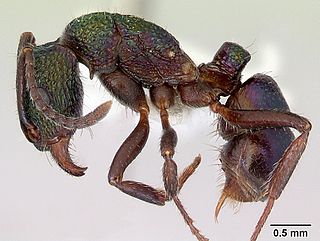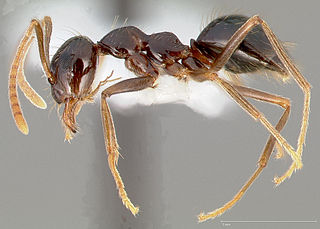
Dolichoderinae is a subfamily of ants, which includes species such as the Argentine ant, the erratic ant, the odorous house ant, and the cone ant. The subfamily presents a great diversity of species throughout the world, distributed in different biogeographic regions, from the Palearctic, Nearctic, Afrotropical region and Malaysia, to the Middle East, Australian, and Neotropical regions.

Aphaenogaster is a genus of myrmicine ants. About 200 species have been described, including 18 fossil species. They occur worldwide except in South America south of Colombia, Sub-Saharan Africa, and Antarctica.

Myrmicaria is an ant genus within the subfamily Myrmicinae.

Rhytidoponera is a large genus of ants in the subfamily Ectatomminae. The genus is known from Australia and Melanesia, with New Caledonia as the most eastern limit.

Cerapachys is a genus of ants in the subfamily Dorylinae. Species are mainly myrmecophagous ants which raid the nests of other ants for prey. The genus is distributed widely throughout the tropical and subtropical regions of the world, with the majority of species known from the Indo-Australian region.

Sphinctomyrmex is a genus of ants in the subfamily Dorylinae. The genus is a pantropical and distinctive group, originally described by Mayr based on a single gyne collected in Brazil. Morphologically, the genus is characterized by the unique arrangement of the gastric segments, which are nearly equal in length and separated from each other by distinct constrictions. Very little is known on the natural history of Sphinctomyrmex. The few observations so far suggest that ants of this genus are nomadic predators of other ants.

Meranoplus is an Old World genus of ants in the subfamily Myrmicinae. With over 80 valid species, it is predicted that over half of the Meranoplus diversity remains undescribed, most of these from Australia.

Stigmacros is an Australian genus of small ants in the subfamily Formicinae. The genus is endemic to Australia. They are generalist predators that forage in the leaf litter, on the ground or in trees.

Pseudolasius is a genus of ants in the subfamily Formicinae. The genus is known from southern Asia to northern Australia, where it appears to be restricted to tropical areas.

Prenolepis is a genus of ants in the subfamily Formicinae. Most species are found in southeastern Asia and southern China, but the genus has a wide distribution with species known from North America, southern Europe, Anatolia, Cuba, Haiti, and West Africa.
Myrmecia ludlowi is an Australian ant which belongs to the genus Myrmecia. This species is native to Australia and is commonly distributed in Western Australia. They were first described by Crawley in 1922.

Myrmecia auriventris is an Australian ant which belongs to the genus Myrmecia. This species is native to Australia and is commonly distributed in Queensland.
Myrmecia clarki is an Australian ant which belongs to the genus Myrmecia. This species is native to Australia and is commonly distributed in Western Australia.
Myrmecia swalei is an Australian ant which belongs to the genus Myrmecia. This species is native to Australia and is commonly distributed in Western Australia and South Australia. It was described by Crawley in 1922.
Arnoldius scissor is a species of ant, one of three species described in the genus Arnoldius. Native to Australia, it was described by Crawley in 1922.

Bothriomyrmecini is a tribe of Dolichoderinae ants with 5 genera.
Dolichoderus niger is a species of ant in the genus Dolichoderus. Described by Crawley in 1922, the species is endemic to Australia, and can be seen in scrub like habitats in Western Australia, and has been observed in native woodland around the city of Perth.














